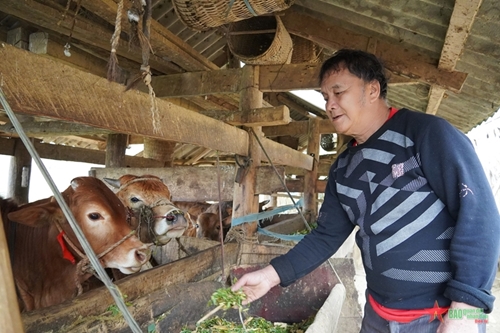Those achievements have been attributed to the Government’s economic development facilitation policies, investment, and local authorities’ efforts.
Son Vi has 19 hamlets, of which nine are situated in border areas. The border commune has more than 1,300 households with a total population of over 7,800 people. All the residents are ethnic minority people.
    |
 |
|
Giang Chu Sinh in Leo Cha Phin B hamlet, Son Vi commune takes care of cows. |
Due to the challenging terrain characterized by high mountains and deep valleys, coupled with harsh weather conditions and limited awareness among locals, the local authorities are concentrating their efforts on making the most of the available funding and support policies of the Government and province, especially the National Target Program to improve the living conditions of the people.
Giang Chu Sinh’s family in Lao Cha Phin B village is one of the 20 households benefiting from the Cow Breeding Support Project implemented as part of the National Target Program by the commune. Under this project, each household is provided with VND 18.4 million to purchase breeding cows. Upon receiving the information that his family was eligible for the project, Giang Chu Sinh planted an additional 0.5 hectares of grass to ensure a stable food source for the cow and renovated its barn. Sinh said that his family is focusing on taking good care of the breeding cow with the hope of soon escaping poverty.
Gia Thi Gia’s family is another poor household receiving a donation of VND 18.4 million. By now, her cow has given birth to a calf, serving as motivation for her family to expand their domestic economy to improve the living standard. Gia said that the project has given poor and near-poor households like hers an opportunity to overcome poverty sustainably. “We are grateful to the Party and the Government for their concern for the poor in the mountainous areas," said the local woman.
According to Chairman of Son Vi commune People's Committee Thao Mi Sinh, in order to effectively implement the cow breeding model, the local authorities have assigned each official and civil servant to observe and regularly report on the model's implementation. Furthermore, specialized officials have accompanied local people and guided them to efficiently utilize the provided funds. Thanks to these efforts, 70% of the breeding cows owned by households have given birth to calves, and they are developing well.
Thao Mi Sinh added that in 2023, the total cultivated area was over 1,280 hectares; the total grain production in the crop year reached 2,580 tons. The total number of cows exceeded 8.800. More than 700 locals had jobs with an average income of VND 21 million per person in 2023. The poverty rate in the commune decreased from 69.35% to 55.72%.
The cow breeding model in Son Vi commune has supported poor and near-poor households in their economic development. This model has helped enhance the effectiveness of state investment, create employment opportunities, and increase income for the poor, thus contributing to the local authorities’ poverty reduction efforts. It is one of the appropriate economic and social development policies and solutions in accordance with the local reality. This is a proof that the socio-economic development guidelines and solutions are in accordance with actual situation of the locality.
Translated by Tran Hoai